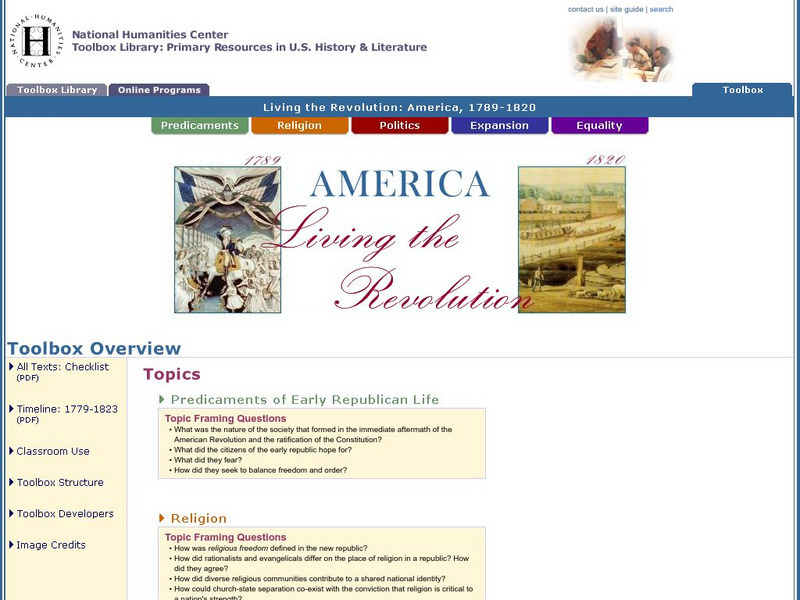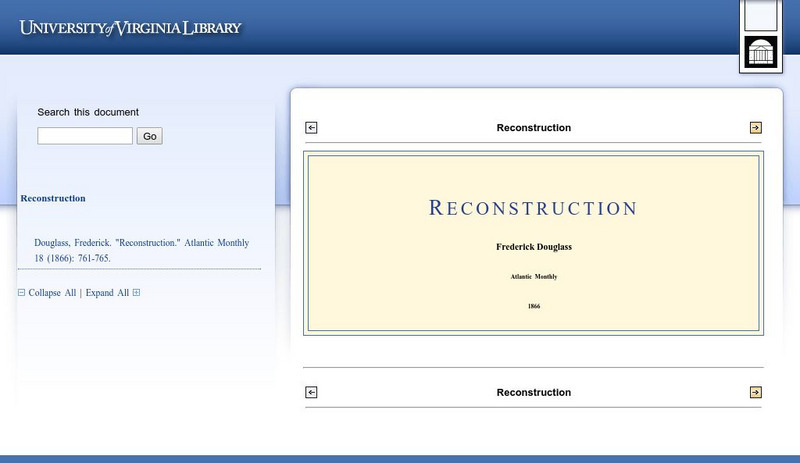DocsTeach
Confronting Work Place Discrimination on the World War II Home Front
Before the Civil Rights Movement was in full swing, FDR's executive order helped promote fair employment. The activity uses primary documents to explore FDR's executive order to help minorities gain equal employment and pay during the...
Teaching Tolerance
Talking About Race and Racism
Set the stage for discussion in a thought-provoking instructional activity on racism. An informative resource prepares scholars to discuss the history of race and racism with a quiz, vocabulary, and guidelines. Academics discuss topics...
Facing History and Ourselves
The Audacity of a Vote: Susan B. Anthony’s Arrest
Susan B. Anthony's speech "Is It a Crime for Women to Vote?" takes center stage in a lesson that asks class members to consider how they might respond to what they consider an unjust law. Groups work through the speech paragraph by...
C-SPAN
14th Amendment Equal Protection Clause
Two Supreme Court cases, Plessy v. Ferguson and Brown v. Board of Education take center stage in a lesson about the Equal Protection Clause of the 14th Amendment. Class members research both cases to compare and contrast the rulings.
Just Health Action
How are Equality and Equity Different?
Equality does not equal equity. That's the take-away from a lesson plan that asks young people to consider what could be done to make a variety of situations more just, more equitable. After examining images that illustrate the...
Just Health Action
Causes of the Causes: What Are the Root Causes of This Problem?
A "Causes of the Causes" diagram enables class members to examine the contributing factors to a problem. After reading a poem that models the process, class members, either in gorps or individually, diagram an issues they are passionate...
Teaching Tolerance
Why Do We (Still) Celebrate Columbus Day?
What are we really celebrating on Columbus Day? The resource explores the narrative behind Columbus Day and ways for people to change the perception. Scholars also review vocabulary terms associated with the topic and how attitudes have...
Equality and Human Rights Commission
Learning area 5: Job Done!
Four activities conclude a unit through discussion and activities inspired by reflection. Scholars revisit their storybook from the first unit. Self-portraits showcase thought bubbles with written statements. Groups write and perform a...
Teaching Tolerance
Using Photographs to Teach Social Justice | Advertisements Promoting Activism
Activism can create real change. Class members examine a series of photographs that represent a different form of activism. Individuals then craft a persuasive speech in which they argue why the photo they chose is the best example of...
Teaching Tolerance
Using Photographs to Teach Social Justice | Confronting Unjust Laws
The right to peacefully assembly to protest injustice is a key element of the First Amendment to the United States Constitution. Class members are asked to analyze two photographs of people confronting what they consider to be unjust...
National Woman's History Museum
The Road to Suffrage
Scholars each research a different entry on the included suffrage timeline that lead to the ratification of the 19th Amendment. Using a minimum of three sources, investigators add what they have learned to a combined class Suffrage...
Radford University
SAT and ACT – How Equitable Are They?
Test the test takers' knowledge of statistics about data from the SAT and ACT tests. Future collegians explore the idea of gender and racial bias in high-stakes college admissions exams. They analyze historical data on average scores by...
PHET
Equality Explorer
Find the right balance between concrete and abstract thinking. After using interactive balances to explore inverse operations, learners solve multi-step equations with variables on both sides. Of course, they can still use the...
Illustrative Mathematics
Using Lengths to Represent Equality
Match the length in more than one way. Pupils work in pairs to create equal lengths using different combinations of rods. The quick activity allows learners to develop a physical understanding of equality and realize there is more than...
ProCon
Gay Marriage
The first legal gay marriage in the United States occurred in Massachusetts in 2004. Since then, countless others have tied the knot. Scholars decide whether gay marriage should be legal by reading a history of the issue, analyzing the...
Judicial Learning Center
Civil Rights and Equal Protection
Almost every American is familiar with the Supreme Court case of Brown vs. Board of Education. Far fewer understand the constitutional reasoning or the wide-ranging consequences of the ruling in the field of criminology. The interesting...
BBC
Bbc World Service: I Have a Right To
How well do you know your own rights? This site aims to help people make good choices and understand issues that directly affect them such as freedom, equality, safety, domestic violence, and the law. Choose a human rights case study for...
National Endowment for the Humanities
Neh: Edsit Ement: Civil Rights Movement
This lesson plan on the Civil Rights movement is organized into three sections: "Identifying the Need for Change," "Ordinary People in the Civil Rights Movement," and "Historic Places in the Civil Rights Movement."
National Humanities Center
National Humanities Center: Toolbox Library: Living the Revolution: America, 1789 1820
Over thirty primary sources explore the American Revolution covering the topics of early republican life, religion, politics, expansion, and equality. Includes notes and discussion questions.
National Humanities Center
National Humanities Center: Teacher Serve: Reconstruction and the Formerly Enslaved
What are the "big questions" of Reconstruction? Article provides an overview of the Reconstruction period when Americans debated rights and the nature of freedom and equality. It focuses on who was an American and how citizenship should...
Center For Civic Education
Center for Civic Education: Dr. Martin Luther King Jr. Day
Three lessons for recognizing Dr. Martin Luther King Jr Day, taken from the We the People: The Citizen & the Constitution curriculum. These materials will help inform students about the national struggle for civil rights and equal...
PBS
Pbs Learning Media: Modern Boom Family
This Wide Angle video explores the effects of economic prosperity and secularization on family structure and beliefs in Ireland.
PBS
Pbs Learning Media: Breaking New Ground
This video from Wide Angle provides a look at some of the women who are leading Rwanda in government, business and promoting peace.
University of Virginia
The University of Virginia Library: Reconstruction, by Fredrick Douglass
A document on Reconstruction written by Fredrick Douglass. He argues particularly for voting rights for blacks as the most necessary step to avoid the kinds of state's rights conflicts that brought about the Civil War.





















